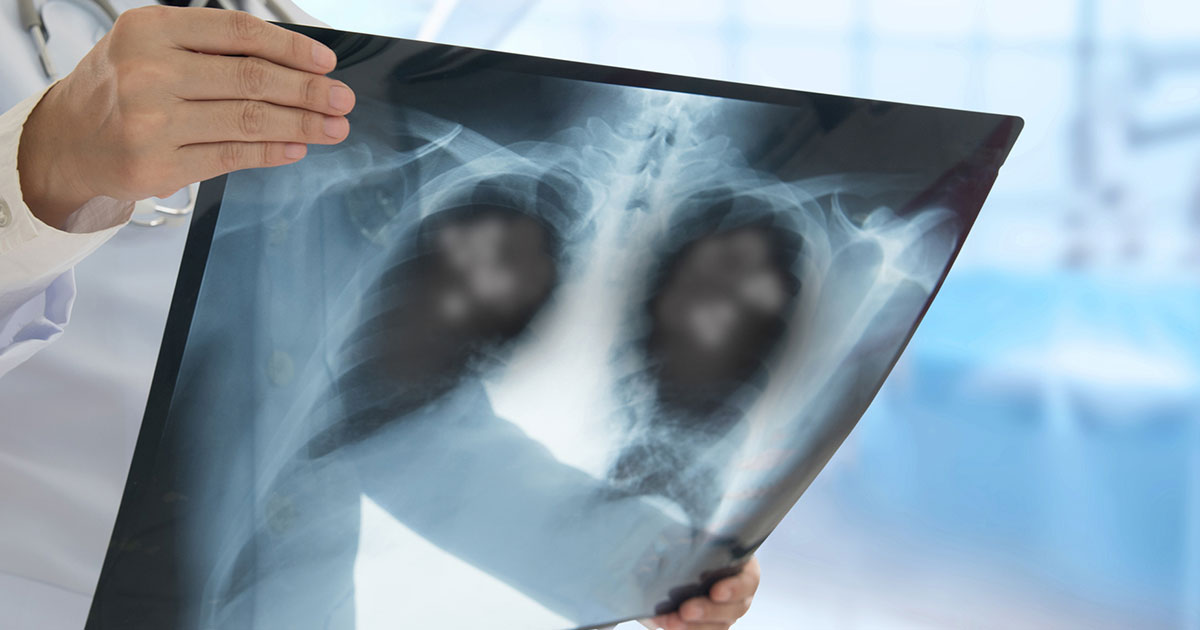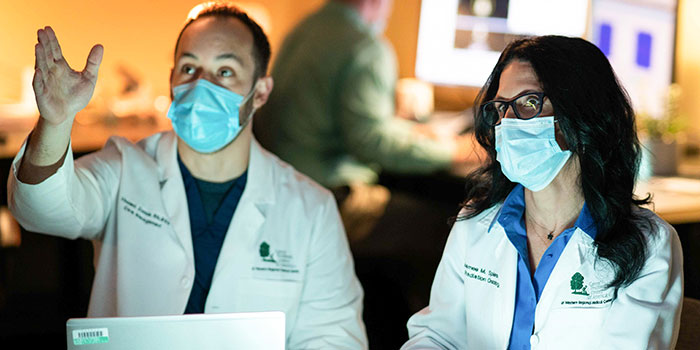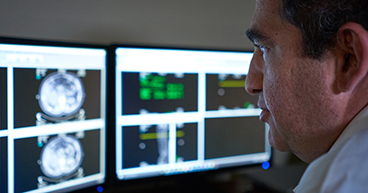
If you've recently undergone a scan that revealed a nodule on your lungs, you're probably worried, and you probably have questions. Is a nodule a lung tumor? Does it mean you may have lung cancer?
This news can create a lot of anxiety. Even if your physician tells you the pulmonary nodule is probably noncancerous, most likely he or she has told you the nodule needs to be rechecked every few months with follow-up scans, or that you may need to undergo more tests.
Lack of clarity regarding your future health can be stressful. You want answers, and it can be very frustrating not knowing how long it's going to take to get them. And, in some health care settings, it may take months.
First, you may be comforted to know that, while lung nodules may be an indicator of lung cancer, benign nodules are common. Common lung nodule causes may include scar tissue, previous infections or other reasons. A CT (computed tomography) scan alone may not be enough to confirm or rule out lung cancer. Lung nodules vary in shape, size and type, and physicians follow specific guidelines in determining whether more testing, such as a PET/CT (positron emission tomography) scan or a lung biopsy, is warranted.
To help you get the information you need, this article answers common questions about lung nodules, including:
- What does a spot on your lung mean?
- Can a CT scan tell if a lung nodule is cancerous?
- What are the benefits of getting an early lung cancer diagnosis?
- What should you do if you have a pulmonary nodule?
- Our rapid lung-nodule diagnosis program
If you've recently been told you have a lung nodule and would like to talk with someone at City of Hope about getting a diagnosis, call us or chat online with a member of our team.
What does a spot on your lung mean?
Lung nodules, pulmonary nodules, white spots, lesions—these terms all describe the same phenomenon: an abnormality in the lungs.
What is a pulmonary nodule?
Pulmonary nodules are abnormal growths that form in the lung. They're typically smaller than 3 centimeters in diameter.
Lung nodules are commonly found after a patient undergoes a chest CT scan for some reason, such as when a patient experiences symptoms of lung disease or during a lung cancer screening. Sometimes, a physician inadvertently spots a lung nodule while doing a CT screening of the patient's abdomen due to unrelated stomach pain or after an accident.
In a CT scan, the lungs appear as two black sponges with thin white lines running through them. That's because lungs are filled with air, and air looks black on a CT scan or a chest x-ray. Lung nodules, in turn, are white specks in that black space, meaning there’s something else in your lungs where there should only be air.
Once patients have been told they have a pulmonary nodule, the first question they usually ask is: Is it cancer?
Can a CT scan tell if a lung nodule is cancerous?
The short answer is no. A CT scan usually isn't enough to tell whether a lung lesion is a benign tumor or a cancerous lump. A biopsy is the only way to confirm a lung cancer diagnosis. But the nodule’s characteristics as seen on a CT scan may offer clues.
To determine whether the likelihood of lung cancer is high or low, physicians usually look at three distinct characteristics of the nodule: the size of the spot, its shape and whether the nodule is calcified.
- If the CT scan shows small nodules (less than a centimeter wide, or about the size of a green pea), they have a low probability of being cancerous. Larger nodules are more worrisome.
- Rounded nodules are less likely to be cancerous than spiculated (having jagged edges) ones.
- Calcified lung nodules contain calcium deposits that sometimes form in response to infection. These nodules are most likely noncancerous.
The care team may also consider the lung nodule's location when assessing possible risk. Studies suggest that nodules located in the upper lobe of the lung may be more indicative of cancer. Not all nodules in that location are cancerous, however, and not every lesion elsewhere in the lung is benign.
Another key sign physicians look for when trying to determine whether a lung nodule may be cancerous is the difference in the size of the nodule between one scan and another taken at a later time. Cancerous nodules are more likely to grow. If the white spot enlarges between scans, that may be an indication of lung cancer.
So, while a CT scan can't confirm whether your lung nodule is cancerous, it may determine whether further imaging tests are warranted. If this is the case, your doctor may order a PET scan and/or a biopsy of the suspicious lung tissue.
If the characteristics of your lung nodules indicate the possibility of cancer, experts recommend you undergo testing as soon as possible to determine whether your lung nodules are malignant or benign. If they’re benign, you get the peace of mind of knowing that. If they’re malignant, there are many benefits that come with getting an early lung cancer diagnosis.
Lung mass vs. nodule
Pulmonary lesions larger than 3 cm are typically considered lung masses and not nodules, but not every lung mass is cancerous. If the care team identifies a mass on your lung, they’ll talk to you about scheduling additional tests, which may include a biopsy and/or a PET/CT scan.
What are the benefits of getting an early lung cancer diagnosis?

There’s a significant difference in lung cancer survival rates for cancers diagnosed in the early stages and those diagnosed at stage 3 or stage 4—which is when the majority of lung cancers are diagnosed.
When lung cancer is found when it’s localized—meaning there’s no evidence it’s spread outside the lungs—it’s much easier to treat than when it’s spread to regional (near to the lungs) or distant areas of the body.
Early symptoms of lung cancer may include:
- A cough that’s new, worsens or produces blood
- Shortness of breath
- Chest pain when coughing or laughing
- Unexplained weight loss
- Lung infections that won’t go away
Many patients with lung cancer, though, don’t have any symptoms until the cancer has advanced to later stages. This initial lack of symptoms is why most lung cancers are diagnosed after they’ve advanced.
Once patients do experience symptoms, however, researchers have found that the average amount of time between seeking medical attention for those symptoms and the start of treatment is about 138 days. Such a delay gives the cancer even more time to grow and metastasize and leads to higher anxiety levels for the patient.
This is why getting the appropriate tests to determine whether a nodule is cancerous is so important, even if you don’t have any other risk factors for lung cancer.
At City of Hope, we recommend you undergo yearly lung cancer screenings if you're at high risk of lung cancer (e.g., a life-long smoker), even if your lung nodule turns out to be benign.
Why you should undergo yearly lung cancer screenings if you're at high risk of lung cancer
Lung cancer screenings are like mammograms or colonoscopies: a test that checks to see whether high-risk individuals have developed suspicious signs of cancer, or if cancer does develop, helps catch it as early as possible.
While mammograms and colonoscopies have garnered significant awareness over the years, the percentage of people who undergo yearly lung cancer screenings is very low. In fact, among people eligible for yearly lung cancer screenings in the United States, only about 5.8 percent get screened.
The United States Preventive Services Task Force advises that you're at high risk of lung cancer if both of these apply to you:
- You’re between the ages of 50 and 80.
- You’re either a current smoker or a former smoker who smoked a pack a day for 20 years and quit smoking less than 15 years ago.
What should you do if you have a pulmonary nodule?
If you’ve been told you have a lung nodule, you should consult a pulmonologist or someone with training and experience in detecting and treating lung nodules or lung cancer. These doctors may be better equipped to offer the proper guidance and order further testing (when appropriate) to determine whether you have lung cancer.
You might also want to consider getting a second opinion. Getting a second opinion from a cancer center with a multidisciplinary approach to cancer diagnosis and care may help alleviate the stress and anxiety that comes with finding out you have a lung nodule.
Many patients come to City of Hope for a second opinion because of our personalized approach to cancer care and comprehensive treatment options. Patients with lung nodules, specifically, come to us for a second opinion because of our unique rapid lung-nodule diagnosis program.
The City of Hope rapid lung-nodule diagnosis program: Why we started it and how we approach cancer care

We've seen many patients feeling stressed and anxious for weeks or months after finding out they have nodules in their lungs. They either didn’t have clear answers about their lung nodules or weren’t comfortable with the answers they received. There’s no need to live with that anxiety.
We also know how crucial time is when it comes to diagnosing and treating lung cancer. That’s why we created our rapid lung-nodule diagnosis program, with results delivered in as few as four days.
At the rapid lung-nodule diagnosis program, we respect our patients’ time and need for peace of mind by reducing the time between when patients first discover they may have nodules in their lungs and the moment they find out whether those nodules are cancerous.
Before you even get to your first scheduled appointment, our team of cancer experts has already researched and reviewed your CT scans. Our tumor board consists of interdisciplinary experts, including an interventional radiologist, an interventional pulmonologist, a thoracic surgeon, a medical oncologist and a radiation oncologist—all reviewing your CT scans and medical records together.
Working together, we can better identify whether your lung nodules are suspicious for cancer. If they are, we schedule the appropriate tests as quickly as possible. These diagnostic procedures may include a PET scan, genomic testing, a bronchoscopy, endobronchial ultrasound or needle biopsy, depending on what’s appropriate for your case.
By day four of the program, we’ll give you a clear answer about what needs to happen next. If you don't have lung cancer, we all celebrate and you go on your way. If you do have malignant nodules and a lung cancer diagnosis, you can get started with treatment right away.
Worrying about a lung nodule and the possibility of cancer is both normal and valid. We understand that patients need answers, and they need them as soon as possible. Our patients’ peace of mind and well-being are our top priority.
If you’re interested in scheduling an appointment with our rapid lung-nodule diagnosis program, call us or chat online with a member of our team.


